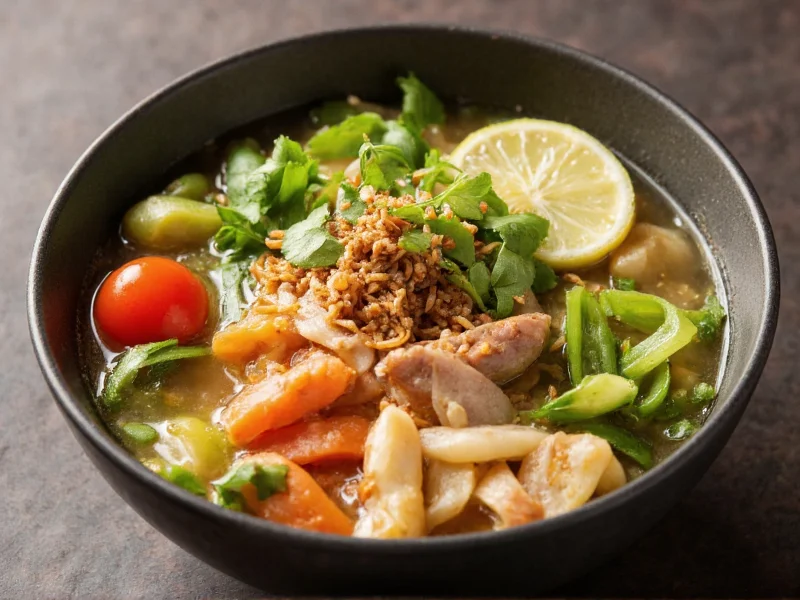Pho soup represents one of Vietnam's most iconic culinary exports, captivating palates worldwide with its delicate balance of flavors and textures. This traditional Vietnamese noodle soup has evolved from humble street food origins to global culinary phenomenon while maintaining its essential character. Understanding what makes pho truly authentic requires examining its historical roots, preparation methods, and cultural significance beyond the common Western adaptations.
Historical Origins and Cultural Evolution
Pho emerged in northern Vietnam around the early 1900s, during French colonial rule, when beef became more accessible due to French cattle farming practices. The name likely derives from "pot-au-feu," the French beef stew, adapted through Vietnamese pronunciation. Initially sold by street vendors carrying shoulder poles with broth pots at each end, pho spread south after the 1954 partition of Vietnam, evolving distinct regional styles.
Northern pho (phố Hà Nội) maintains minimalist purity with clear broth, flat rice noodles, and simple garnishes. Southern pho (phố Sài Gòn) features sweeter broth, wider noodles, and abundant herbs. This regional divergence reflects Vietnam's complex culinary landscape, where local preferences shape even nationally beloved dishes.
Anatomy of Authentic Pho
The magic of exceptional pho lies in its carefully balanced components. Each element serves a specific purpose in creating the complete sensory experience:
| Component | Traditional Elements | Purpose |
|---|---|---|
| Broth | Beef bones (marrow bones, knuckles), charred onion & ginger, spice bundle (star anise, cinnamon, cloves, cardamom) | Provides deep umami foundation; clarity indicates proper skimming |
| Noodles | Bánh phố (flat rice noodles), fresh not dried | Delicate texture that absorbs broth without becoming soggy |
| Protein | Raw beef slices (brisket, flank, eye of round), sometimes meatballs | Cooks gently in hot broth; quality cuts essential |
| Herbs & Garnishes | Fresh basil, cilantro, scallions, bean sprouts, lime, chili, hoisin & sriracha | Adds freshness, acidity, and customizable flavor layers |
Regional Variations Across Vietnam
While all pho shares core elements, regional differences reveal Vietnam's culinary diversity. Northern versions feature restrained broth with minimal sugar, narrow noodles, and limited garnishes—respecting the broth's purity. Southern iterations incorporate rock sugar for subtle sweetness, wider noodles, and abundant herbs and bean sprouts.
Specialized regional variations include:
- Pho cuon (Hanoi) - Noodles wrapped around meat
- Pho chua (Hai Phong) - Sweet and sour variation with duck
- Pho ga (Nationwide) - Chicken-based alternative
- Pho chay - Vegetarian version using mushroom broth
Nutritional Profile and Health Considerations
Authentic pho offers surprising nutritional benefits when prepared traditionally. The long-simmered bone broth provides collagen, gelatin, and minerals. A standard bowl (about 450g) typically contains:
| Nutrient | Amount per Serving | Health Benefit |
|---|---|---|
| Calories | 350-450 | Reasonable energy source |
| Protein | 25-35g | Supports muscle maintenance |
| Sodium | 800-1200mg | Higher than ideal; request less fish sauce |
| Collagen | Significant | Supports joint and skin health |
Modern adaptations sometimes compromise authenticity with MSG-heavy bases or excessive sodium. To maximize health benefits, seek establishments using natural ingredients and request less sodium. Vegetarian pho versions using mushroom or vegetable broth provide excellent alternatives for non-meat eaters while maintaining traditional flavor profiles through careful spice balancing.
Identifying Authentic Pho Experience
Not all establishments serving "pho" deliver authentic experiences. True pho requires time-intensive preparation that commercial shortcuts often compromise. Key indicators of quality include:
- Broth clarity - Properly skimmed broth appears nearly transparent
- Aroma complexity - Distinct spice notes without overwhelming any single element
- Noodle texture - Slightly chewy with no starchy residue
- Meat quality - Thinly sliced, high-grade beef that cooks properly in broth heat
- Herb freshness - Vibrant, crisp garnishes served separately
Many Western restaurants modify pho to local tastes—adding excessive sugar, using inferior broth bases, or serving oversized portions that dilute the delicate balance. The most authentic experiences typically come from family-run establishments where preparation follows traditional methods, often with recipes passed through generations.
Common Misconceptions About Pho
Several myths surround this beloved dish. First, pho isn't simply "Vietnamese ramen" – while both are noodle soups, their broths, noodles, and cultural contexts differ significantly. Second, authentic pho broth shouldn't taste overly sweet; sugar additions are primarily Southern adaptations. Third, hoisin and sriracha sauces are optional accompaniments, not essential components – many purists consider them unnecessary additions that mask the broth's subtle flavors.
Understanding these distinctions helps appreciate pho's unique culinary identity rather than viewing it through Westernized interpretations. The dish's global popularity has led to creative adaptations, but recognizing traditional preparation methods preserves respect for its cultural origins.
Cultural Significance Beyond the Bowl
Pho represents more than sustenance in Vietnamese culture—it embodies community, resilience, and national identity. During difficult historical periods, pho vendors provided affordable nourishment while preserving culinary traditions. Today, sharing a bowl of pho remains a communal experience, often enjoyed during family gatherings or as morning ritual.
The global spread of pho has created cultural bridges while raising questions about authenticity and appropriation. Vietnamese chefs worldwide navigate balancing tradition with local tastes, ensuring this culinary treasure maintains its essence while evolving naturally. When enjoyed with understanding of its origins, pho becomes more than food—it's a connection to Vietnamese heritage and craftsmanship.











 浙公网安备
33010002000092号
浙公网安备
33010002000092号 浙B2-20120091-4
浙B2-20120091-4